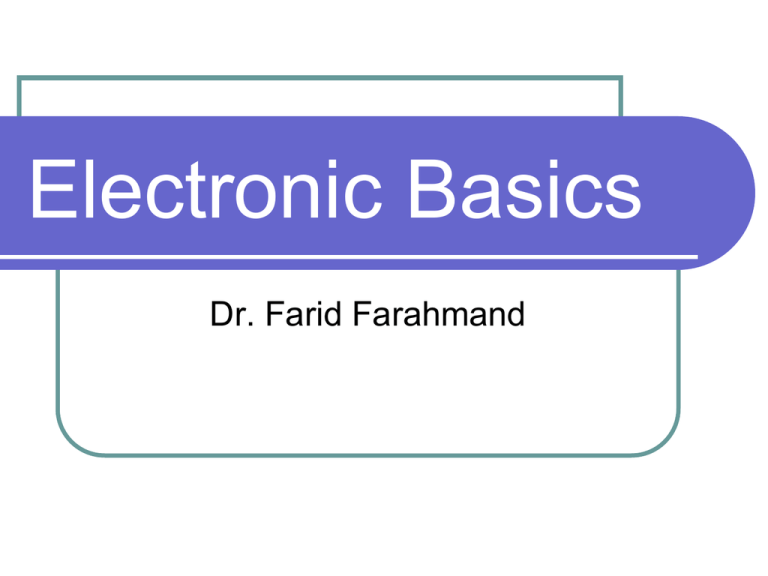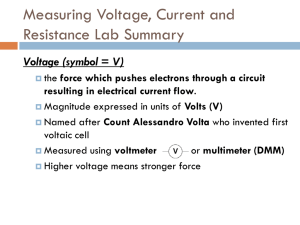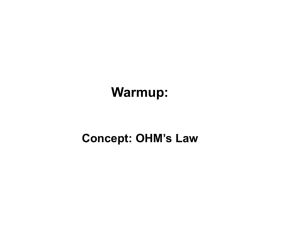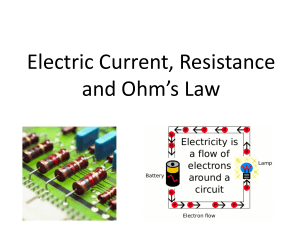Electronic Basics Dr. Farid Farahmand
advertisement

Electronic Basics Dr. Farid Farahmand Outline Reviewing basic concepts: Voltage, Current, and Resistance Ohm’s law Power and Energy Introduction Electricity is everywhere! But what is it? Movement of electrons Electrons move all over the place in a conductor They glide through like marbles sliding on the floor Less resistance More moving The electrons can move but something must move them The force that moves electrons from one place to another is called voltage Electrical Energy Electrical Energy can be generated from different forms of energies Coal, oil, natural gas Nuclear or solar energy Creates steam to drive a turbine that generates electricity. Creates steam to drive the turbine. Solar photovoltaic or fuel cells and batteries Rely upon chemical reactions to generate electricity Sun Farm Networks http://www.sunfarmnetwork.com/25647_105755.asp Electrons Electricity is due to excess of electrons! Smallest molecule is Hydrogen Free electrons Electricity Atom Structure An atom is the smallest particle of an element that retains the characteristics of that element. An atom has a nucleus, consisting of positively charged particles called protons, and uncharged particles called neutrons. The basic particles of negative charge, called electrons, orbit the nucleus. Voltage The unit of voltage is the volt (V). One coulomb is the total charge possessed by 6.25 x 1018 electrons. Q = (number of electrons)/(6.25 x 1018) By definition: One volt is the potential difference (voltage) between two points when one joule of energy is used to move one coulomb of charge from one point to the other. 1 Joule of Energy 1C The potential difference is one Volt! Voltage Sources A battery is a type of voltage source that converts chemical energy into electrical energy. Solar Cells convert light energy into electrical energy. Generators convert mechanical energy into electrical energy. Electronic power supplies (voltage converters)? They do not produce electrical energy, but they transform the ac voltage from the wall outlet into a constant dc voltage for use in our circuits. Current Current definition The movement of free electrons from negative to positive is electrical current (I). Electrical current is the rate of flow of charge I = Q/t One C of charges/sec The Unit of Current is Amp One amp is the amount of current that exists when a number of electrons having a total charge of one coulomb move through a given cross-sectional area in one second. Movement of Electrons Early experiments appeared as if flow of electrons is from + voltage to – voltage But in reality, flow of electrons is from voltage to + voltage When electrons move from - + terminals, the flow is called an electric current Voltage is the driving force in electric circuits and is what establishes current Current Flow Current flow can be Direct or Alternating Direct or DC: Electric flow is only in one direction Alternating or AC: Electric flow is in one direction and then in another Property of material that resists the flow of electrons is called resistance AC DC Resistance The property of a material that restricts the flow of electrons is called resistance. The unit of Resistance is Ohm (). By definition One ohm of resistance exists if there is one ampere of current in a material when one volt is applied across the material. Applying 1 V 1 A of current is generated There must be 1 ohm of resistance! Ohm’s Law Ohm’s law describes mathematically how voltage, current, and resistance are related. I = V/R Hence, current and voltage are linearly proportional. In resistive circuits, with a constant resistance, if voltage increases or decreases by a certain percentage, so will current. On the other hand, current and resistance are inversely related. With constant voltage, if resistance is reduced, current goes up; when resistance is increased, current goes down Energy and Power Energy is the ability to do work - joules (J) Power is the rate at which energy is used - in watts (W) By definition: One watt is the amount of power when one joule of energy used in one second. Power = energy/time P = W/t Kilowatt-hour The kilowatt-hour (kWh) is frequently used as a unit of energy. One kWh is used when one thousand watts is used for one hour. Power utilized over a period of time represents energy consumption. W = Pt Energy can also be expressed as wattseconds (Ws), watt-hour (Wh). Power in an Electric Circuit There is always a certain amount of power in an electric circuit, and it is dependant on the amount of resistance and the amount of current, expressed as: P= 2 IR Resistance- Remember The property of a material that restricts the flow of electrons is called resistance. The unit of Resistance is Ohm (). By definition One ohm of resistance exists if there is one ampere of current in a material when one volt is applied across the material. Applying 1 V 1 A of current is generated There must be 1 ohm of resistance! Color-code bands on a resistor 1st band is the first digit of the resistance value. 2nd band is the second digit of the resistance value. 3rd band is the multiplier (number of zeros). 4th band indicates the tolerance. Examples: http://www.ccsu.edu/technology/farahmand/ccsu/courses/cet233/cet_233.htm#Resistors Resistor color code Ohm’s Law Given R=10 ohm; how will this graph look like? Ohm’s Law Voltage and Current Measurements To measure voltage, the voltmeter is placed in parallel across the component; that is, one lead is place on each side of the component. To measure current, the ammeter must be placed in series with the component; that is, it must be in line with the current path. Voltage and Current Measurements To measure voltage, the voltmeter is placed in parallel across the component; that is, one lead is place on each side of the component. To measure current, the ammeter must be placed in series with the component; that is, it must be in line with the current path. Analyzing the circuit: Total resistance = 10+15+22+3.3=50.3K I=V/R = 0.298 mA What is the measurement error? About %2 error! Where does the error come from? What is the measurement error across 15K resistor? 304.2 μ 4.469 6.509 Check the numbers! Make sure you understand how we got them! Current Measurements 304.2 μ 4.469 6.509 Voltage Measurements 304.2 μ 4.469 6.509 DO THIS PRE-LAB: See the Web site! LAB Find the resistance of the giver resistor using its colors Check the calculated value using a Multi-meter Connect two resistors in series and measure the total resistance Connect two resistors in parallel and measure the total resistance References http://people.clarkson.edu/~svoboda/eta/dcWorkout/OandKLawsR. html http://people.clarkson.edu/~svoboda/eta/dc Workout/VandCDividers.html http://people.clarkson.edu/~svoboda/eta/ec sa.html - Main page http://people.clarkson.edu/~svoboda/eta/dcWorkout/EquivCkts.html Equivalent circuits http://jersey.uoregon.edu/vlab/Voltage/ - batteries and circuits http://www.colorado.edu/physics/phet/simulations/cck/cck.jnlp - A complete circuit analyzer References www.dannyg.com/javascript/res/resload.htm phet.colorado.edu/new/index.php







